Prior to launching Ebutemetaverse, I had ZERO personal experience with search engine optimization or ranking on Google.
All I ever did was write articles based on what clients gave me… keywords and the instruction to “reverse engineer” the top-ranking article.
But between July 2022 and July 2023, I grew a website’s traffic from 0 to 35K clicks in 12 months and a consistent 6K monthly visitors.
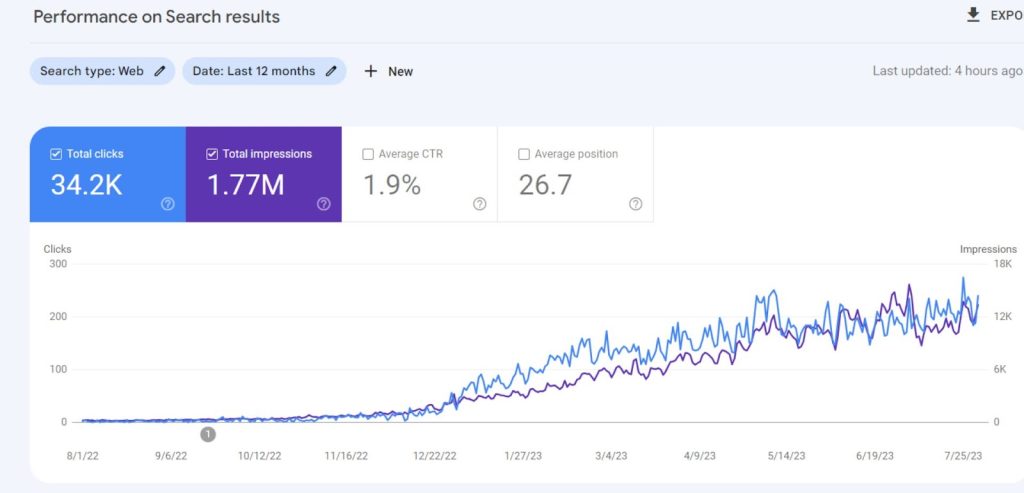
What you’ll learn:
- Choosing a niche: how I chose the niche and the key aspect you should consider when choosing one
- Keyword research: the process I used to select keywords and build clusters
- Content research and writing: the nitty-gritty of researching your content and writing articles that satisfy search intent
- Technicals: consider this a technical SEO for beginners guide—without the technicals.
Case Study: Building Ebutemetaverse to 35K Clicks in 12 Months
Summary:
I registered a new domain for the NFT/Web3 niche to test every SEO tactic I’ve ever come across.
Cos, honestly, you can’t tell a client you’re an SEO content writer without personal proof and case studies, right?
I got some writers on board and collectively wrote 80 articles in 12 months, increasing the site’s organic visitors by 6,214% within that timeframe.
Challenge:
I had ZERO experience with keyword research and creating a content map. Also, the domain was fresh with zero backlinks or any prior SEO work done on it.
Plus, my competitors were already ahead with over 100+ articles. How do I publish that many articles and meet up with the competition?
Results:

- Ranking in the top 3 position for 149 keywords
- Attracting 6,134 visitors monthly
- Getting a natural backlink from GoBankingRates
- Dominating 312 Search Engine Result Pages (SERP) features, including snippets and People Also Asked (PAA).
Choosing a Niche
The first step to complete before creating a website is choosing your niche.
Now, there are a lot of resources online for how this works, so I’ll just list out what I considered when choosing NFTs as my niche.
1. Profitability:
Find a niche that has a lot of profit potential, either from ads or product sales. I learned this the hard way. 😅
The fact is that managing a website is expensive.
SEO is expensive.
If you don’t take this into consideration from the beginning, you’ll find it difficult monetizing your traffic.
2. Competition:
For me, NFTs weren’t super competitive at the time. So, ideally, you can find an upcoming trend or niche down to a subsection of a huge market.
For instance, instead of focusing on “personal finance” which is too competitive, you can focus on “personal finance for single parents” which is not too competitive but still profitable.
3. Expertise:
Only go for a niche that you know something about or can find good writers with large experience in that niche. I had been following the NFT space since it gained traction in 2021, so I already had some expertise.
Plus, I got help from GorillaZap’s NFT team… because, you truly can’t scale without the right hands.
Keyword Research Process
So, I first tried using a Fiverr gig to get my keyword research done.
While the seller gave me a spreadsheet full of keywords… which was what I ordered, anyway 😅… it wasn’t enough to start building.
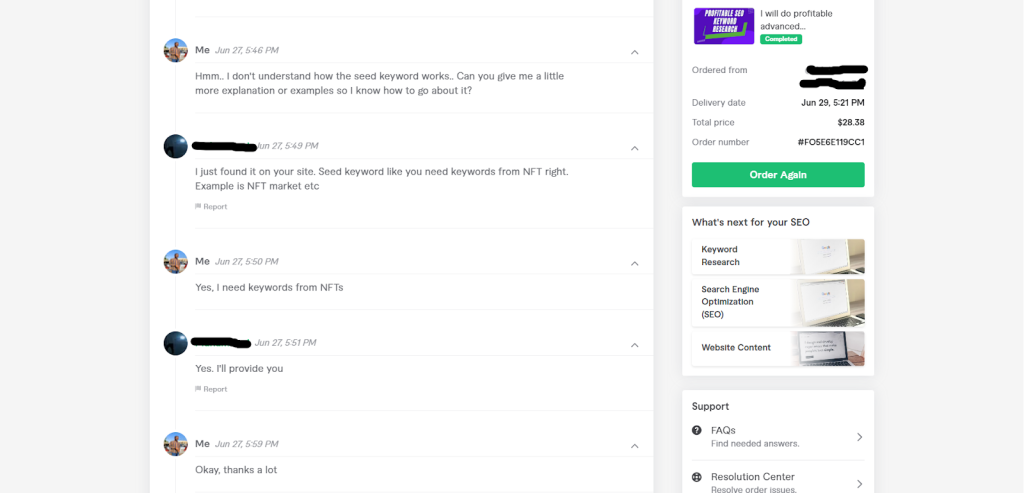
So, here’s what I did.
- Find a competitor (I went for cyberscrilla.com)
- Crawl their site for what they’re ranking for
- Start creating content
But was this enough to push my site?
Not in the slightest. You see, starting out keyword research from competitor analysis is one of the best ways to start.
However, it can take a lot more to start seeing results.
Cos, in SEO, what’s good for the geese might hurt the gander.

So, here’s the exact process that worked for me:
- Find a competitor
- Crawl their site for what they’re ranking for
- Export keywords competitor ranks for
- Look for gaps in the SERP for these keywords (for starters, look for ranking sites with a domain authority below 20)
If you noticed, I didn’t mention keyword difficulty.
The reason is that KD changes over time. And the only way to know what you can easily rank for is by analyzing the SERP.
The only downside is that you’ll need to manually Google search each keyword (which might take up to a month).
To speed things up, I found this tool Lowfruits.io, which helps identify these gaps without you manually searching each keyword.
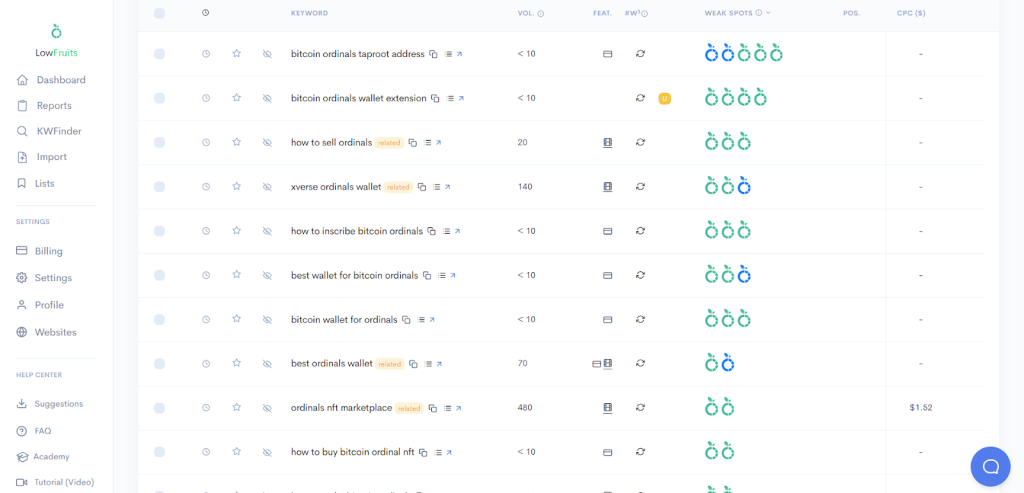
The Ubersuggest Chrome extension also helped with my SERP analysis.
Creating Clusters
It’s not enough to just get keywords or find gaps in the SERP… although, you can go pretty far with that.
One critical aspect to your success is creating clusters. Clusters are a group of keywords that are related in terms of intent, semantics, or SERP features.
For instance,
“how to mint nft on opensea”
Should be in the same cluster as;
“how to create nft on opensea”
TL;DR: I see clustering as grouping related keywords to improve your ranking potentials for an article… so you don’t also end up with cannibalized pages.
Some people might explain it differently, anyway.
So, to cluster your keywords, you can also use lowfruits.io (my favorite) or keywordinsights.ai.
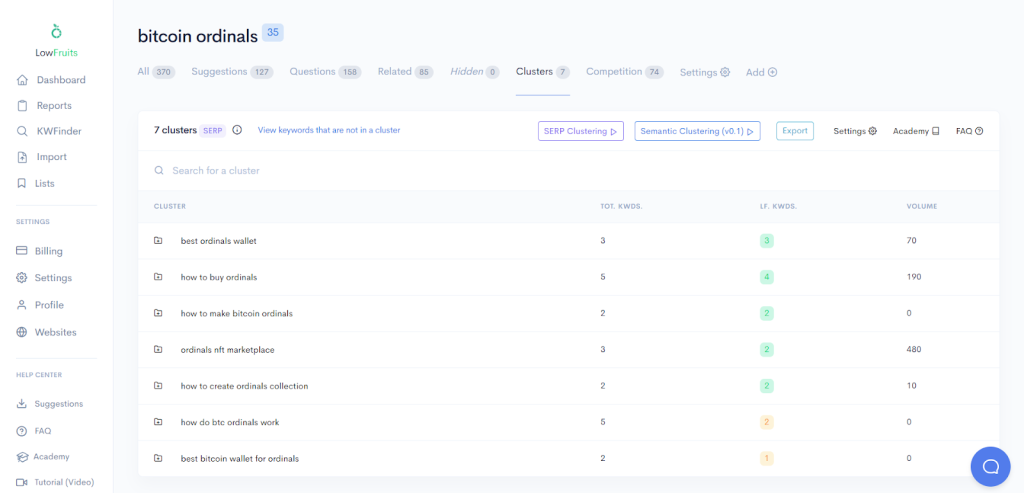
Prepping Content Brief
Now, that I had my keywords, the next step was to prepare content briefs before writing.
Content briefs are super important because they give you a clear picture of what to include and how to structure your content.
Now, most writers just like to look at the top 10 and start writing immediately.
While this might seem like the fastest route, it can quickly backfire…
You’ll lose sight of the search intent and may even write off-topic.
Here’s why you need a content brief.
- Content briefs help you maintain the search intent, which will keep your readers engaged
- You’ll have a defined structure based on what Google already loves to improve your ranking potential
- You can specify your tone, CTA, and other important info so you don’t forget them while writing
- It allows you to easily share and assign tasks to people, especially if you want to work with a writing team
You can check out a content brief sample I used for Ebutemetaverse or download a template.
Here’s how to create a content brief:
- Analyze the SERP menu to see what Google currently prioritizes for each search term
- Read the top 5 – 10 articles to understand the key points covered
- Use an extension HeadingsMap to extract all the heading tags and create your outline
- Specify your primary keyword and meta information (title, description, etc).
- Get your clusters using lowfruits.io
- Use a tool like Semrush or thruuu.com to scrape LSI keywords
- Get relevant FAQs from the PPA section (you can use some of the questions as H2 tags instead; it’ll increase your ranking potential).
- Compile everything in one document so you can always go back to them at any time.
Writing the Content
Your keyword research and content brief might be on point.
But if your content doesn’t come out well, your efforts will be in vain, especially if you don’t have a content writing background.
I’ve been writing since 2017, so it wasn’t difficult for me.
But even then, I still had help to speed things up.
So, here’s what I noticed from my articles that ranked on page one.

1. Answer first:
Always answer your query in the first two or three paragraphs.
You may be tempted to stall a bit and provide the answer to your target keyword somewhere in the middle or end.
But it doesn’t always work.
The reason is that you’re writing for humans. And humans don’t have patience.
We always want a straightforward answer without stressing.
So, your introduction should provide the solution they need upfront while the rest of the article breaks things down in depth.
2. Put your keywords correctly:
Ensure your keywords are in the introduction, H2s (ideally the first or second), and conclusion.
I can’t explain the mechanics behind this.
But I found out that it helps the crawlers easily understand what the topic is about.
Also mix things up with your LSI and cluster keywords to make it richer.
3. Reduce the grammar; no one cares:
Yes… I love this one 😂 don’t be tempted to add those huge verbose and fancy words (unless your audience is High Valerians).
For Ebutemetaverse, I knew my audience was everyday people who really didn’t care about the tech.
So, I tried to simplify things as much as I could.
The faster people understand your point, the higher their chances of sticking around.
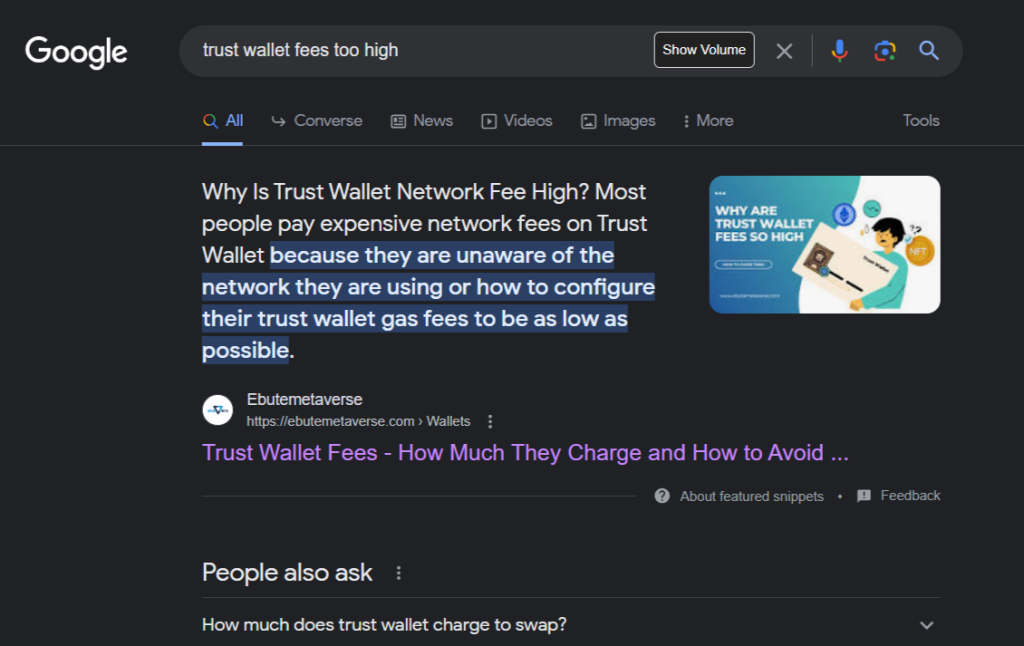
4. Be as practical as possible:
Another key factor to writing great content that will rank is offering as much value as possible.
And this means providing detailed steps and guides.
Someone searching for “how to launch an NFT collection” doesn’t need to read what NFTs are.
They already know that.
Instead, go straight to the point and only give a short intro to NFTs if needed (that’s if your ranking competitors added it).
5. Images, Images, Images:
I can’t stress this enough. Add images and screenshots to your articles, especially if it’s a how-to article. Also, don’t forget to optimize the alt text to increase your SERP opportunities.
Another thing is to create custom images instead of stock photos.

I currently get traffic from some of the images on Ebutemetaverse because they also add value to the content and not just there for show.
You can use Canva to create a template for all your images, then tweak and edit as needed.
Easy peasy.
💡PS: embed relevant videos in your articles as well to boost your chances… it doesn’t matter if you created it or not.
One way to do this is to find videos from the main platforms you’re talking about.
Publishing Frequency & Time to Rank
So, how did I go about publishing?
Well, I didn’t set any kind of schedule, though I made sure to publish at least 2 articles per month.
There were months were I published around 5-6 articles.
The key here is to maintain a certain level of consistency.
If you want to rank faster, publish more, faster.
Keep in mind that you will not rank for all your articles. But when you keep publishing, it increases your chances of getting some on first page.
It took me about 5 months and 20 articles to get on the first page and win my first set of featured snippets.
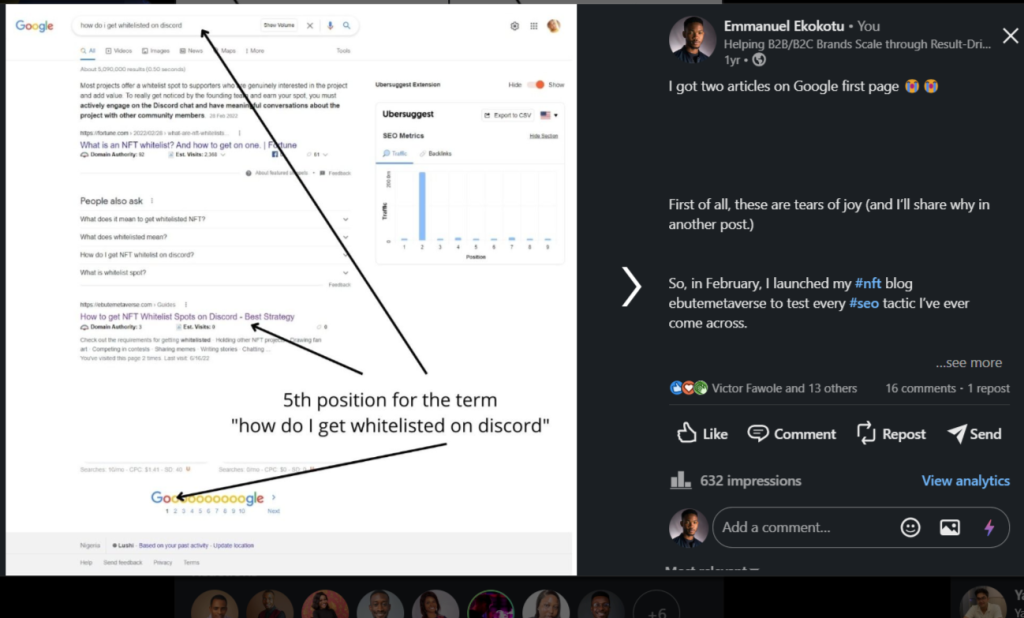
On-Page & Technical SEO Tactics
The majority of the SEO work I did was on-page (the content itself).
So, you’ll want to ensure that your content is already keyword-rich based on all the parameters I explained under the keyword research and content writing sections.
Now, what other SEO tactic did I use on the website?
Nothing too complicated;

- I created the website myself using a light theme so it doesn’t slow down when loading
- I ensured the website was loading super fast (I got someone on Fiverr to do it… best gig ever).
- Created easy categories to make navigating content easier.
- I used Rankmath PRO for optimizing the content on the website (it also helped with faster indexing).
- Set up Google Search Console to track my progress and see when I start ranking or not (pretty easy if you’re using WordPress… you just install a plugin).
- Submitted my sitemap on Search Console. This speeds the process of getting my content crawled. You can create an automatic sitemap using RankMath.
And that was pretty much everything I did.
Off-Page SEO Tactics
This is the part almost everyone struggles with… and the most expensive of all.
Off-page SEO is essentially building backlinks to your website to grow its authority.
I currently have about 500+ referring domains to Ebutemetaverse.
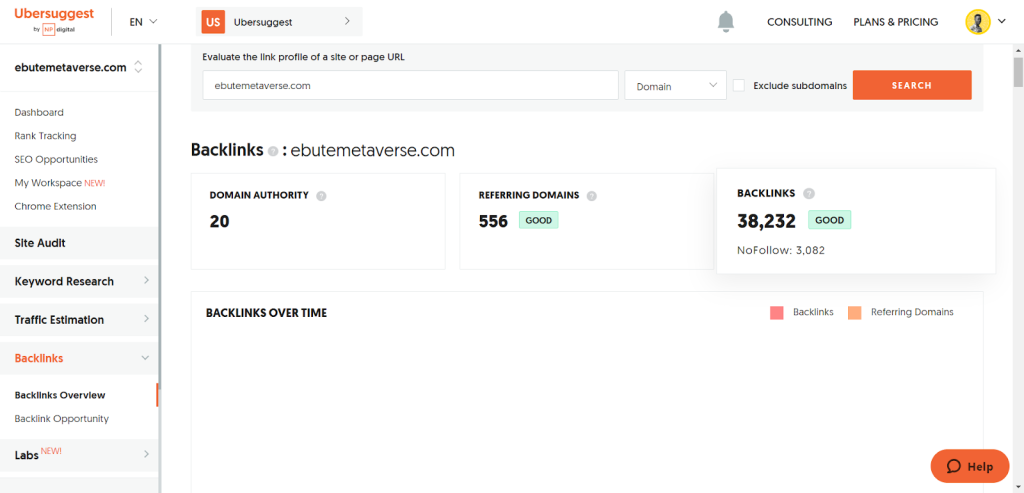
If you punch the SEO calculator, that’ll be worth… a lot.
I didn’t even know how to go about getting them, especially since I was working on a small budget.
So, I did some research and found some tactics I could use:
- Creating valuable content that’ll attract natural links – free and the best option, but slow and unpredictable.
- Launching a digital PR campaign – paid and worked great but best for bigger brands.
- Using expired domains – a bit of grey-hat SEO that’s less expensive but highly dangerous if not done right.
- HARO – reaching out to reporters and getting free backlinks – also free and one of the best options, but needs a lot of time.
Since I was looking to maximize my budget, I went for the first and third options.
For creating valuable content, I was already doing that from day one, and it landed me some pretty good links, like the backlink I got from GoBankingRates.
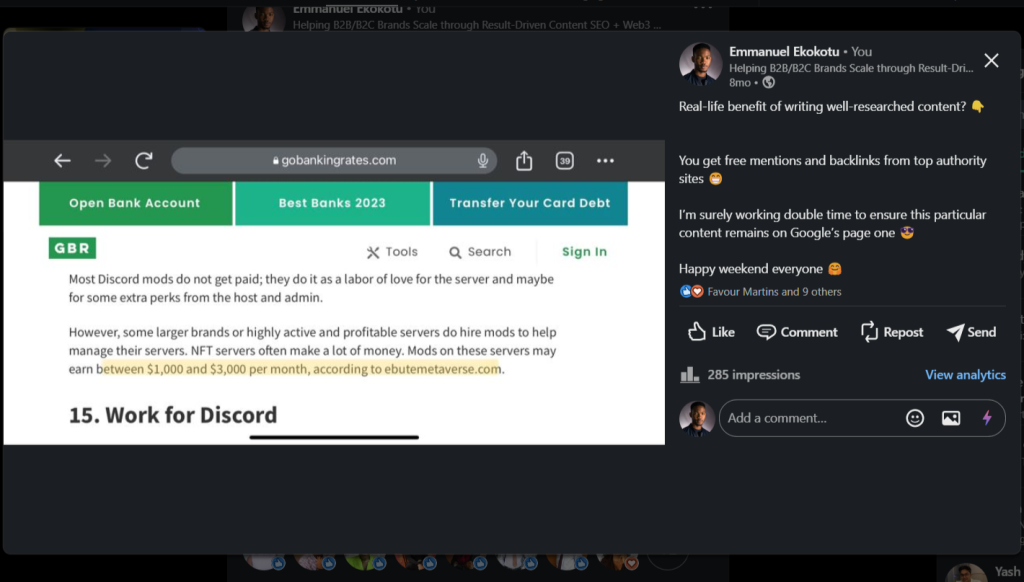
For expired domains, I didn’t know where to begin.
So, I reached out to Justin Ford on LinkedIn, and he gave me some pointers, which I then implemented.
I’ll create a full article on this later on, but here’s a video from Matt Digity about expired domains.
Revenue & ROI
So far, I’ve only made about $70 from ads from the website 😅
And it’s because I didn’t plan monetization from the beginning… after all, it was a test blog.
However, the website has actually landed me several high-paying gigs on Upwork and LinkedIn.
I shared my progress on LinkedIn from day one… it’s what gurus call “building in public.” From there, I got potential clients reaching out.

Plus, I usually attach the website’s stats to proposals when pitching on Upwork to give me an added advantage.
So, it’s still a win.
Current State & Future Plans
Well, the last few months have been rocky, with traffic dropping to 2,000 monthly visits—down from 6,000.
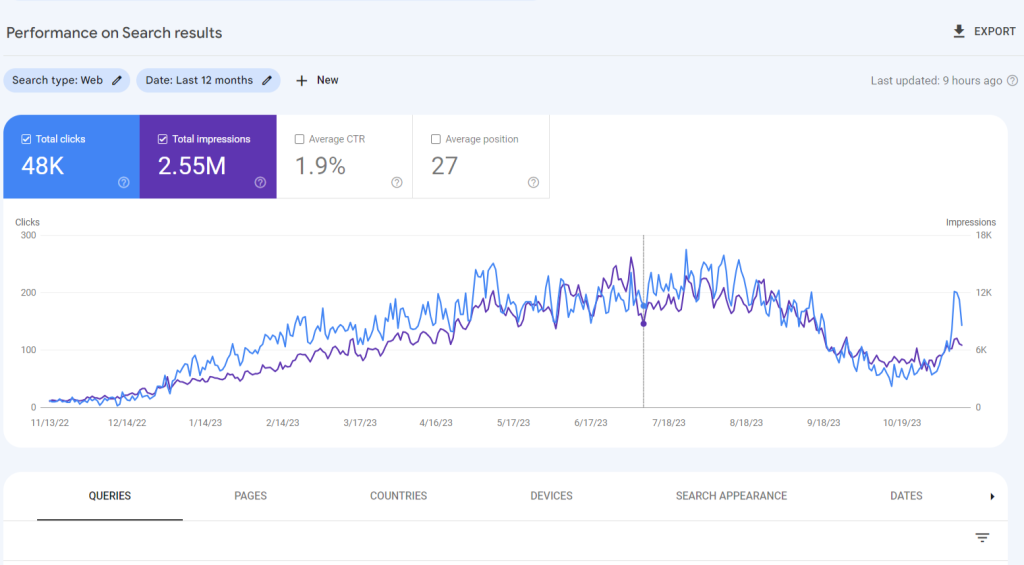
In part two of this review, I’ll cover what exactly happened and what I’m doing to get back the traffic.
Ensure you’re following me on LinkedIn to get my latest case studies.

